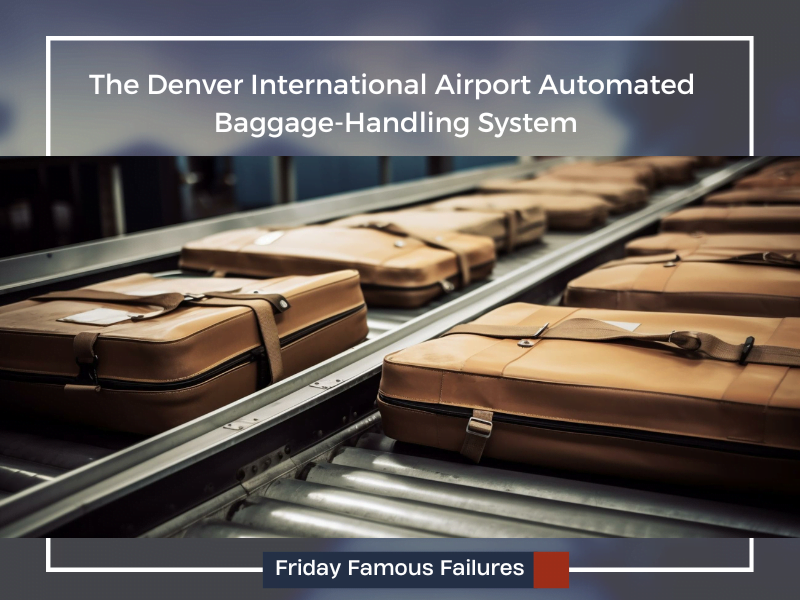The Denver International Airport (DIA) is renowned for its iconic tent-like structure, but it is also infamous in engineering and project management circles for its ambitious yet flawed automated baggage-handling system. This system, which was intended to revolutionize the airport industry, instead became a case study in the pitfalls of over-ambitious engineering and poor project management.
The automated baggage-handling system was designed in the early 1990s to be the jewel in DIA’s crown. It promised to use cutting-edge technology to transport luggage from check-in to aircraft with minimal human intervention, thereby increasing efficiency, reducing mishandled luggage, and improving passenger experience. However, the system never fully functioned as intended, leading to significant delays in the airport’s opening and substantial financial losses. There were many factors that led to the failure of the system.
Causal Factors
- Unproven Technology: The system was based on unproven technology that had never been used on such a large scale. The use of automated carts to transport luggage was a novel idea, but the technology was not mature enough to handle the complexity and volume of luggage at DIA. The carts often malfunctioned, leading to delays and lost luggage.
- Complexity: The system’s complexity was a major technical challenge. It was designed to handle 60,000 bags per day, with a network of 21 miles of conveyor belts and track, and hundreds of autonomous carts. The system was intended to use barcodes and radio frequency identification (RFID) tags to track and sort bags. However, the system often misread or failed to read the barcodes, leading to misrouted bags.
- System Integration: The system was designed to integrate with the airport’s other systems, such as check-in and flight scheduling. However, this integration was poorly executed, leading to further technical issues. For example, if a flight was delayed or rescheduled, the system often failed to update the baggage routing information, leading to bags being sent to the wrong planes.
- Capacity: The system was not designed to handle peak volumes of luggage. During peak times, the system was overwhelmed, leading to jams and delays. This was a fundamental design flaw that could not be easily fixed.
- Reliability: The system was plagued by reliability issues. The autonomous carts often collided or derailed, and the conveyor belts frequently jammed. These reliability issues led to frequent system shutdowns and contributed to the airport’s inability to open on schedule.
- Software Issues: The software controlling the system was also problematic. It was supposed to coordinate the movements of hundreds of carts and thousands of bags, but it often failed, leading to system-wide shutdowns. The software was also unable to effectively manage the system’s complexity and volume, leading to further technical issues.
The City of Denver had warning signs early on that were not heeded.
- Upon commencing airport construction, the city enlisted Breier Neidle Patrone Associates to assess the feasibility of the proposed baggage system project. The firm outright stated that the plan was overly complex. Nevertheless, the city chose to pursue the project despite the cautionary advice.
- Drawing from the experience of a similar, but simpler project in Munich, which took a full two years for completion and six months of rigorous 24/7 testing before launch, it became evident that the much larger and more intricate Denver International Airport system was being squeezed into an extremely tight two-year timeline. The Munich airport authorities warned that this approach was destined to fail. Despite these concerns, the City of Denver decided to press ahead without adjusting their schedule.
- When the airport invited bids for the new luggage system project, only three companies submitted proposals. None of these proposals projected completion within the given timeframe. Undeterred, the city rejected all three bids and approached a fourth company, BAE Systems, urging them to take on this nearly impossible project without extending the proposed timeline.
From a project management perspective, the baggage-handling system was a textbook example of scope creep and poor risk management. The project’s scope was expanded mid-way through construction to include all airlines, not just United, which dramatically increased its complexity. This decision was made without a thorough risk assessment or consideration of the additional resources and time required.
The failure led to significant financial losses. The airport opened in February, 1995, 16 months behind schedule with cost overruns estimated at $560 million, much of which was attributed to the baggage system. The system was eventually decommissioned in 2005, and a traditional manual system was installed in its place.
However, the failure also led to some positive changes in the industry—it highlighted the importance of thorough testing and risk management in large-scale projects, and spurred innovation in baggage handling technology, with a greater focus on reliability and scalability.
In conclusion, the failure of DIA’s automated baggage-handling system was a significant event in the history of airport engineering and project management. It serves as a stark reminder of the risks of over-ambitious engineering and poor project management. However, it also provides valuable lessons that can help prevent similar failures in the future. The key takeaways are the importance of thorough risk assessment, realistic project scope, adequate testing, and the careful implementation of new technology.









The one thing you missed is that the Scope Creep was likely do to upper-level people who were only looking for the praise that would come with as system that could do it all. Missing who the stockholders are is the fastest way to have a project fail. Often those who are told to make it happen, are not listened to. Failures of this type happen because those making the decisions are lacking the technical experience to make those decisions. This leads to Scope Creep and eventual project failure.
It was a political/politics/politicians failure.
It is not the first and will not be the last engineering failure event
Very interesting case. A system like this should have been installed in a smaller airport first. I think that governments should always spend capital money based on high level of assurances and not ambitions.
Reading the article I see that there were overruns in the area of $560 million dollars, however I wonder what were the direct costs attributed to the baggage handling system itself. As noted by Kamal above it sounds like the system should have been installed at a smaller airport first. Another option would have been going with known technology & having provisions for a cutting edge system to be installed / incorporated at a future date.
Yet Amazon probably does this on a larger scale on a daily basis in its distribution centers. Better design & planning? Using a system integrator who knows what they’re doing?
Unfortunately, politics and engineering make poor bedfellows…..